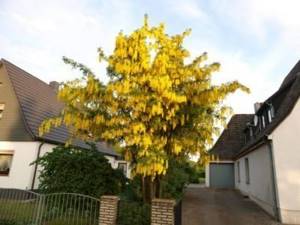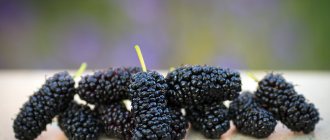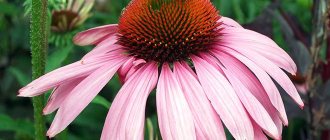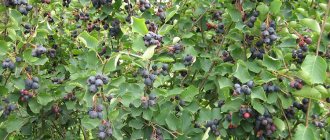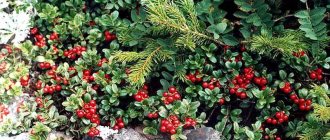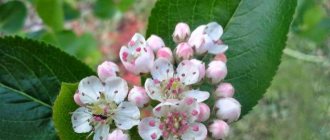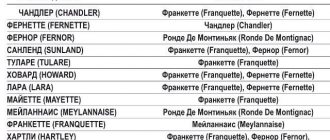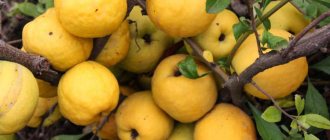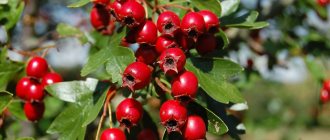General information
The main difference between laburnum and other decorative tree crops is the large inflorescences of yellow, pink, lilac and white, collected in hanging clusters. The brushes reach up to 50 centimeters in length and when flowering they emit a very pleasant aroma, similar to acacia.
If you properly care for the crop, it will delight the gardener with abundant flowering, the period of which will occur at the end of May and lasts until the end of June. When the bean flower fades, fruits in the form of small pods with beans begin to set in place of the inflorescences, thanks to which the tree can reproduce by self-sowing.
Growing this amazing crop is quite simple, the main thing is to take into account all the advice of experienced gardeners and an exotic bean plant will definitely appear on your site, which will delight you with its lush flowering, filling the air with an extraordinary aroma.
Types of bean with photos and names
The bean genus consists of only two species, one hybrid tree and several varieties.
Laburnum anagyroides
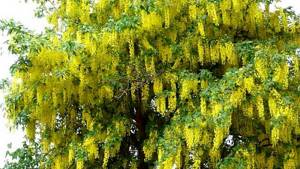
Laburnum anagyroides photo
It is also called “golden shower”. It is a bush or multi-stemmed tree about 6 m high. The inflorescences are about 30 cm long. Flowering will begin in May and last about a month. Able to withstand frost down to -20°C.
Alpine bean Laburnum alpinum
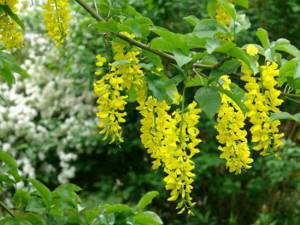
Alpine bean Laburnum alpinum photo
Tree up to 12 m high, spreading, oblong crown. Old branches and trunk are erect, the edges of the shoots droop. Yellow inflorescences 30-45 cm long bloom by the end of May. The plant itself can withstand temperatures down to -25°C, but the ends of the branches may freeze. The plant is common in southern Europe.
Decorative varieties are:
- Pendula - with long, drooping shoots;
- Aurea - in spring, young foliage has a golden tint, but gradually it acquires a rich green color;
- Quercifolia – leaves of incised shape similar to oak leaves;
- Automnale - bestows flowering not only in spring, but also in autumn.
Waterer's bean Laburnum x watereri (hybrid)
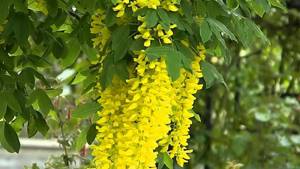
Laburnum x watereri 'Vossii' photo
Obtained as a result of crossing two previous species. It is a bush or tree 1-3 m high. Old erect shoots complete the drooping shoots. The leaves are petiolate and reach a length of 50 cm. The flowers exude an intense, pleasant aroma. They are grown mainly in the southern regions, because the plant is sensitive to frost.
Bean varieties and types
Bobovnik Golden Rain - can be represented either by a compact bush or by a tree up to 6 meters in height. It has large light green three-fingered leaf blades. Laburnum begins to bloom at the end of May and ends in mid-June. The inflorescences are in the form of long yellow clusters that emit a pleasant aroma.
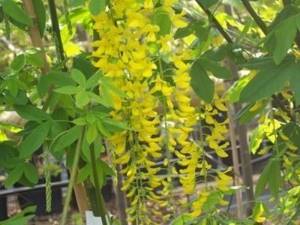
Bobovnik Anagyrofolia - in the wild, the tree grows in mountainous areas. Its height can reach up to 6 meters. The inflorescences are large, long, racemose, golden in color and have a delicate, acacia-like aroma.
Flowering time lasts from late spring to early summer. The leaf blades of this bean variety are medium in size, slightly pubescent below and have a dark green tint. The tree is winter-hardy and tolerates temperatures down to minus 20 degrees.
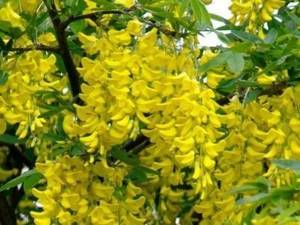
Alpine bean - in nature the tree grows up to 12 meters in height. It has a bush-like crown and large, light green trifoliate leaf blades. Laburnum has large, long racemose inflorescences of bright yellow color, reminiscent of acacia. This bean variety is frost-resistant, although in cold winters the branches of the tree may freeze. Therefore it needs shelter.

Common bean tree is a perennial deciduous tree with a spreading oval crown and a height of up to 7 meters. Often the bean tree has several trunks. The trifoliate leaf blades are oval in shape and light green in color, which darkens with the onset of summer. The bean blooms from May to June, with large long inflorescences of golden, pink, white or lilac hue.
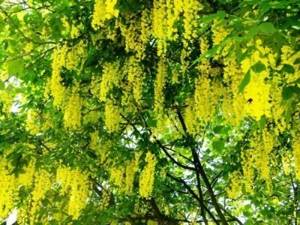
Bobovnik Pink
It is a shrub with a compact crown. It has trifoliate oval leaf blades of a green hue. The tree blooms in spring for two weeks. It has large, long, racemose bright pink inflorescences with a delicate pleasant aroma and extraordinary decorative value.
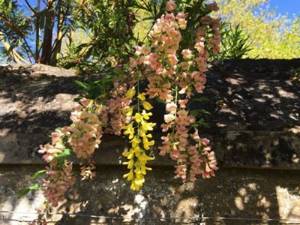
Lilac bobovnik is a tree reaching a height of 2 meters with a spreading, loose crown and several trunks. The leaf blades of the bean are trifoliate with slight pubescence on the inside, light green in color.
Laburnum blooms from late spring to early summer. The inflorescences of the tree are racemose and reach a length of 30 centimeters. They have a rich purple hue and a pleasant aroma, vaguely reminiscent of acacia.
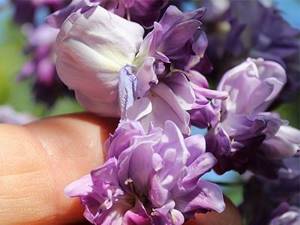
Alpine bean plant Gold Rhine - grows naturally in the mountainous areas of Switzerland and Germany. Laburnum reaches ten meters and looks like a bush-like tree with an elongated crown. In Russia, since the plant often freezes, it has the shape of a bush and will grow only up to 3 meters. The leaf blades of the tree are long, trifoliate, smooth, and light green in color. The bean inflorescences are large, racemose, long and bright yellow.
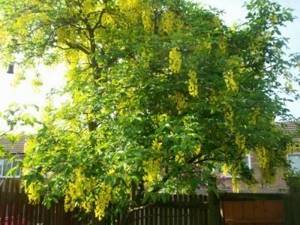
Waterer's bean - the tree is a hybrid of anagyrofolia and alpine bean. It reaches a height of 1 to 3 meters. The leaves are large, long, trifoliate and light green in color. The bean tree blooms from late spring to early summer. Its inflorescences are bright yellow and racemose in shape. They also have extraordinary decorative characteristics and an intense, pleasant aroma.
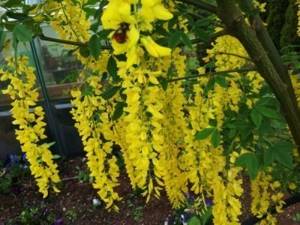
Description of the bean plant
Bobovnik (laburnum) is a perennial deciduous tree or spreading shrub up to 7 m tall. Light brown mottled bark covers the woody shoots. Often a tree can consist of several trunks. The crown is oval, consisting of cascading weeping branches. In early April, foliage emerges from the oval brown buds.
The branches are quickly covered with trifoliate leaves of bright green color. The leaves have a silvery, sparse pile underneath. The color of the leaves becomes darker and more saturated by mid-summer. The leaf blade is oval with smooth edges and pointed ends, attached to an erect, long petiole. The leaf length is 15-25 cm.
How the bean blooms
By mid-May, dense racemose inflorescences bloom on flexible long peduncles (20-50 cm). The flowers emit a sweet, intoxicating aroma, attracting insects to collect nectar. It blooms very profusely. The yellow flowers have a characteristic moth-like shape for the Legume family. One wide petal, covered at the base with reddish strokes, curls over a keeled lip, consisting of lower fused petals. The bean tree blooms from two weeks to 20 days.
After pollination by insects, brown beans covered with silky pubescence will begin to ripen. The beans are up to 8 cm long.
If you decide to have a bean plant in your garden, remember that it is poisonous and the fruits contain the largest amount of toxins.
It is not recommended to plant this plant if there are small children in the family: even a couple of seeds eaten by them can be fatal.
Bobovnik planting and care in the Moscow region
Bean is a crop for which the choice of planting site is not too critical, so it can be planted anywhere in the garden. To plant a shrub, you should choose a lighted place, since due to a lack of light, the crop will stop growing and developing, and flowers will stop appearing on it, or there will be very few of them, and the inflorescences will lose their brightness.
Bobovnik can grow on depleted limestone, so there is no need to frequently fertilize during the growing season. To plant shrubs, it is better to choose a place protected from drafts and wind. Since the tree's root system does not tolerate stagnant moisture, the soil must be loose and well-drained.
To plant a bean tree, you should select several seedlings at once. Together, it will be easier for them to endure the winter, and their massive flowering will create a picture in the garden of simply extraordinary beauty.
Young trees need to be planted in early spring, when the snow has melted and the ground has warmed up well. For planting, you should prepare a planting hole in advance by digging it to a depth of 50 centimeters. At its bottom it is necessary to pour a layer of expanded clay, fresh humus and lime. The bush should then be placed in the hole along with a support to which it should be tied. This is necessary so that the young tree does not break under strong gusts of wind.
After it is placed in the planting hole, it is covered with garden soil, and the space around the trunk is mulched with a thick layer of a mixture of bark, sawdust, moss, straw and peat. When mulching is complete, the tree needs to be watered and the soil lightly compacted.
Purple or Cercis is also a member of the Legume family. It can be grown when planted and cared for in open ground without much hassle, if you follow the rules of agricultural technology. You can find all the necessary recommendations in this article.

Planting beans
You will need: garden bean in a pot, bayonet shovel, scoop, compost, support stick, rope.
To plant a garden bean bush, you need to dig a spacious hole twice as large as the earthen ball of your bush, and mix the excavated soil with compost.
Remove the bush from the pot and slightly straighten the roots. If the earthen ball in the pot is dry, then water it generously first.
We drive a support stick into the dug hole and place our bush there, generously moistened. We place the bush at a depth corresponding to the size of the earthen clod.
We fill the hole with earth mixed with compost, tamp it down and form a watering circle. Then water the bean seedling very generously.
We tie the bean stem to a support stick, and mulch the ground around the seedling with compost.
Garden bobwhite does not need regular pruning; radical pruning is harmful to it. Garden bean is a shrub that has a luxurious natural crown and does not require shaping pruning.
Soil for beans
For planting, you need to choose nutritious soil with good drainage. It is best if the soil is alkaline. Acidic soil will need to be mixed with ash or lime, doing this in the fall, so that planting can be done in the spring.
Laburnum does not like compacted soil and stagnant moisture, for this reason the soil should be well breathable, and there should be no crust left on the top layer of soil after watering. Mulching the tree trunk circle will help avoid this.
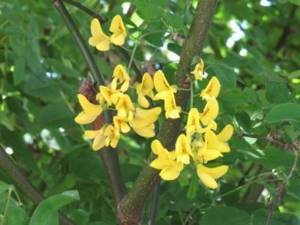
Growing conditions for anagyrofolia
Bobovnik is thermophilic and can only tolerate temperatures down to -23-26 degrees Celsius. As a result, in the colder winter period, its annual growths will freeze, and old shoots may also suffer. Severe Moscow frosts will not allow the plant to turn into a tree, reaching only the size of a shrub no more than 3 meters high. The only fact that saves the plant is its high growth rate (25 cm per year), which allows the bean plant to recover. As a result, we can conclude that this plant is better suited for cultivation in the southern regions. In the Caucasus and Crimea, it will not only delight you with beautiful flowering and fruiting, but also with self-sowing.

Growing beans in the middle zone is quite difficult. Only the correct choice of place and time of planting will provide it with favorable conditions for growth. Like any other heat-loving plant, bean plants are planted in the spring, even if the material is containerized. When buying beans for planting, pay attention to the country of origin. Plants grown in Holland, Italy or Belgium are not suitable for planting in central Russia, exclusively for the southern regions. So DachaDecor.ru advises using planting material from Northern Germany. But even in this case, severe and prolonged winter frosts can kill the plant.
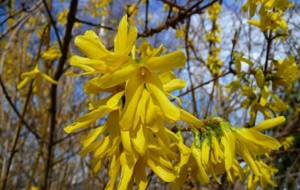
It should also be taken into account that the most frost-resistant and hardy plants are obtained when growing beans from seeds.
Despite the fact that bean grows quite well in partial shade, in our conditions it is better to choose a well-warmed, sunny place protected from northern winds. You can use tree and shrub groups for planting, which are more preferable than single plantings in the open.
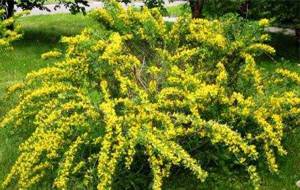
In general, bean grass prefers soils rich in calcium, but it also does well in slightly acidic cultivated loam, and will even grow well in acidic soil. It is quite unpretentious to moisture, loves any fresh soil, but is drought-resistant; it needs to be watered only during particularly dry periods. Mulching promotes good growth of the root system.
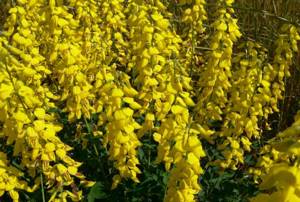
It is better to cover young plantings for the first two to three years. For this, it is best to use non-woven covering material grade 60 with several layers. It is better to sprinkle the root system with compost for additional protection.
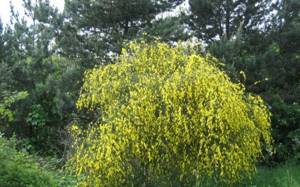
Bean transplant
Replanting the shrub is undesirable, as it does not tolerate it very well. However, if necessary, it must be done very carefully so as not to damage the root system.
For this purpose, the bean should be dug up together with a digger and transferred to a new planting hole, after adding compost to it to ensure better rooting.
After transplanting, the tree must be watered and the trunk circle mulched. Replanting should be done in the fall, after leaf fall.
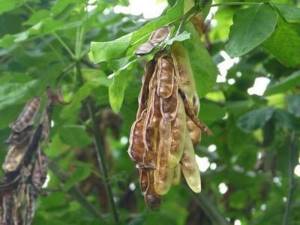
Description of the plant
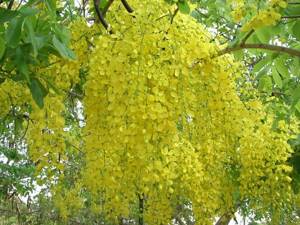
Anagyrofolia or “golden shower” is an ornamental tree or shrub of the Legume family. Bobovnik is found throughout South-Eastern Europe. The plant sometimes reaches 7 meters in height. Between the feathery foliage, yellow, richly shaded inflorescences – multi-flowered racemes – are cast in gold, hanging down. Their length can be up to 30 cm. The bark of the trunk or several woody branches that grow from the rhizome is wrinkled, with furrows, and greenish-gray. Young shoots are slightly pubescent with white hairs.
The shape of the leaf plates is trifoliate, the leaves are silvery below, and bright green above. Flower buds bloom simultaneously with young foliage. The flowering itself begins at the end of April and can continue until the end of summer. After flowering, slightly pubescent bean fruits with a pointed tip covered with white hairs are formed.
Bobovnik is of particular interest to gardeners. There are many forms and varieties of shrubs known. The plant is light-loving, prefers well-drained and fertile soil enriched with lime. The bean plant is used for decorating and landscaping lawns, parks, and personal plots. The plant tolerates winters and frosts down to 25 degrees.
Among the decorative forms of bean, only bean anagyrofolia has healing properties and is successfully used in official and alternative medicine.
Bean flowering
Flowering time occurs at the end of spring - beginning of summer and lasts for a month. Bean inflorescences have the form of thick, large and long racemes, bright yellow, white, pink and lilac in color with a persistent pleasant aroma.
The shrub blooms profusely and attracts insects. In place of faded inflorescences, small dark brown pods with beans are formed, which ripen by the beginning of autumn.
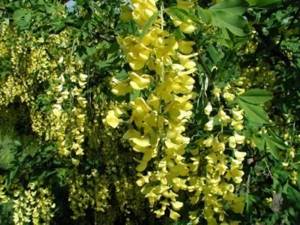
Garden bean - growing “golden shower” in the garden
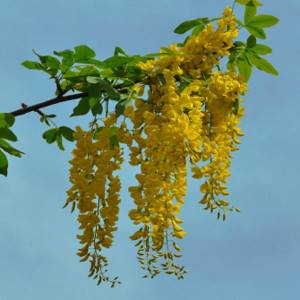
Garden bean (Laburnum) is a very beautiful, unusual and delicate plant. Belongs to the legume family. It got its name due to the shape of its fruits. However, it is not they that are valuable, but the abundant bright flowering. At the end of spring - beginning of summer, long golden brushes, collected from small flowers in the shape of a moth, bloom on the branches. One inflorescence can produce up to 30 bright yellow flowers with a delicate aroma. During the flowering period, a golden shower “flows” through the bush. Flowering does not last long, about 2-3 weeks. Gardeners call the bean plant “golden shower”. There are white and pink shades.
Description of the bean plant
Representatives of the genus grow up to 3-7 m, depending on the species and variety. The spreading crown of weeping or straight flexible shoots can reach a width of 3-4 meters. The leaves are trifoliate, ovate on a long petiole and appear before flowering. The underside of the leaf blade and shoots are slightly pubescent.
The flowering of the bean lasts from late April to June. Small bright yellow flowers are shaped like small butterflies. They are collected in numerous racemose inflorescences, the length of which can reach from 20 to 50 cm.
The fruits in dry narrow pods 5-6 cm long ripen in September. Unfortunately, bean blossoms in cold regions do not bloom often and are not as abundant.
Bean pruning
Formative pruning of the tree does not need to be carried out, since it itself becomes decorative; over time, its branches will take on a beautiful flowing shape.
In the spring, you can remove some of the frozen branches, but this must be done sparingly so that the tree does not get sick. Bean pods should be removed immediately after ripening to avoid self-seeding and improve the decorative qualities of the tree.
Since the branches of the tree have a sloping shape, in winter a large amount of snow sticks to them, and so that they do not break under its weight, they must be carefully shaken off from time to time.
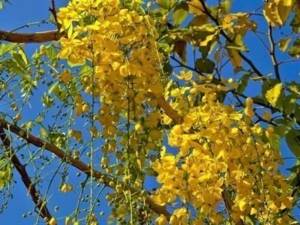
Bobovnik - cultivation
Almond bean is unpretentious, but planting and caring for it must be carried out in compliance with certain conditions. To grow it you need to choose a suitable place. Sometimes it suffers from overheating; it is recommended to plant the bush on an elevated area. It prefers to bloom in sunny places, but can also grow in the shade; lush bouquets are sensitive to drafts and wind. There is also climbing bean - this is a deciduous ornamental tree (“golden shower”) with bright yellow flowering racemes up to 50 cm long, beautifully hanging down. But it and almonds are two different plants.
Bean flower - soil
Planting almond-shaped low legumes is carried out on moderately fertile soils, the best ones are light ones, with abundant organic dressing. For good drainage, brick chips or crushed stone are used (the plant loves rocky soils). It is planted in a nutritious loose mixture of leaf substrate, humus and sand in a concentration of 3:2:1 with the addition of lime. Acidic, saline soils are not suitable for planting and care of beans. Also, it is not placed in an area with high groundwater.
How to plant beans?
The best time to root almonds is early autumn to mid-October. Bobovnik - correct planting:
- holes are dug 30 cm deep at a distance of 3-5 m from each other;
- crushed stone or broken brick is poured onto the bottom;
- a layer of sand is added on top;
- a long pole is driven into the center to support the seedling - at least half a meter;
- the roots of the plant are placed in a clay mash of the thickness of sour cream;
- seedlings are planted in a hole so that the root collar is above ground level;
- the bush is covered with prepared soil substrate;
- the soil is compacted, 10-15 liters of water are poured under the plant;
- the seedling is tied to a support, the circle around the trunk is mulched with a layer of peat 5 cm thick.
If the shrub has to be planted in the spring, the planting hole still needs to be prepared in the fall. Drainage and fertile mixture are placed in it, and the plant takes root in early March. Almonds require cross-pollination, so it is recommended to plant several almond bushes at the same time. Bees are actively flying towards the plant; the proximity of an apiary will be very appropriate.
Bean transplant
The almond-shaped bean flower is easy to grow from seeds at home. The seeds are placed in water for two days, then planted in the ground. After a month, sprouts appear from them. The plant is replanted annually until the age of three in March or after the almonds have flowered. Over the course of a year, the branches rise by 30-40 cm. Rooting in open ground occurs after the plant has grown.
If necessary, you can also replant a plant rooted in the garden. It is best to carry out manipulation in the fall after the leaves have fallen. You need to add a bucket of manure and a glass of organic fertilizer to the new hole. This feeding will ensure better rooting and ripening of the wood. The seedling should not be deepened; the bush tolerates replanting well and painlessly.
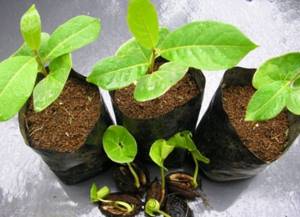
Bobovnik - reproduction
Almond cultivation is done in several ways:
- Root shoots. It is formed in large quantities after pruning the bush. It is better to separate the offspring in the second year, after they have formed a root system. The dug up shoots are transplanted to a permanent place, cared for as for an annual seedling.
- By layering. Flexible almond shoots are bent to the ground and pinned with a metal device, sprinkled with soil. Until the cuttings grow roots, you need to loosen the ground around them, moisten the soil, and remove weeds. After a year, the roots of the cuttings grow, the seedling is separated from the mother plant and planted in a separate place.
- Green cuttings. For propagation, in the second half of July, apical shoots up to 20 cm long with two nodes are cut off. Bean cuttings are carried out in a greenhouse. The shoots are planted in a substrate of one part sand and two parts peat. Rooting occurs after 3-4 weeks. Afterwards, the cuttings with roots are planted in a bed for growing.
- Budding. A well-developed almond shoot in the spring or August is grafted onto the rootstock of plum, cherry plum, and bird cherry growing in the soil, and wrapped with tape. For the winter, the seedling is covered with soil at the grafting site; in the spring, the fixing tape can be removed.
Bobovnik shelter for the winter
If the seedlings were purchased from a nursery, then they will not need additional shelter, since the young trees have already been acclimatized. If they were grown independently, then it is better to protect them by covering them in the fall.
Since young animals are very fragile, they should be bent to the ground carefully. After the branches are bent, the bush must be covered with spruce branches and a thick layer of dry foliage. To prevent them from being blown away by the wind, lutrasil is placed on top of the shelter and pressed down with stones.
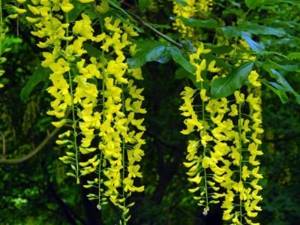
Growing beans from seeds
The bean plant is propagated by seed and vegetative methods. When choosing a seed propagation method, it is better to choose freshly collected seed material.
Some gardeners do not treat seeds before sowing, but it is still better to stratify them. To do this, take the beans, mix them with damp soil or put them in damp gauze. Then they need to be wrapped in plastic and put in the refrigerator for two weeks. After the expiration date, the seeds can be sown.
To sow seed, it is necessary to prepare loose, fertile soil. Sowing can be done in late autumn or spring, after the ground has warmed up. Seeds should be planted in open ground to a depth of 2 centimeters, leaving a distance of 15 centimeters between them.
Seedlings do not require special care and will germinate on their own. You can also grow laburnum on a windowsill by sowing the beans in February. To grow, the young bean will need light and moderate soil moisture. When the young shrubs grow up, they should be moved along with a soil manager to a plot in the garden, where they will grow. Trees grown by seed begin to bloom only after five years.
Bean propagation by vegetative means is considered simpler and more successful. To preserve their unique characteristics, it is best to propagate all varietal plants using this method.
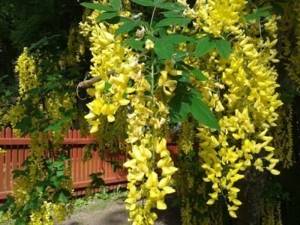
Care
In terms of care, the bean plant is unpretentious. The main measures are to ensure the correct regime of watering, weeding, fertilizing, pruning and preparing for winter.
When caring for beans, you should remember that its juice causes burns and irritation on human skin, so all transplanting or pruning operations should be carried out with gloves. The highest concentration of toxins is found inside the fruit.
Feeding
Additional fertilization is most often not required, since there are enough nutrients that gradually enter the soil from the mulch layer, which is updated annually.
People who want to improve the condition of the bean plant apply mineral fertilizers twice a year:
- in the spring with the beginning of leaf blossoming - nitrogen;
- in August - phosphorus-potassium.
Watering
Broom is a rather unpretentious crop in terms of watering. It may only need additional moisture during long summer droughts. It is more demanding on the level of moisture only in the first year after planting, since the growth rate during the first growing season is very high and the need for water is therefore increased.
After planting, bean plants should be watered once every two weeks during the first month, and then once a month. It is important to ensure that water does not stagnate in the root zone.
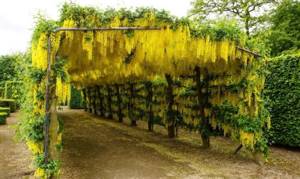
Weeding and loosening
Loosening the soil is necessary in order to ensure normal air permeability and give the site a well-groomed appearance, getting rid of weeds. When performing loosening, you need to be very careful, since the root system of this crop is located in close proximity to the surface of the earth and is very easily damaged. After even individual roots are damaged, the plant may stop growing and suffer for a long time.
Trimming
The crop does not lend itself to formative pruning, so there is no need to make radical changes to the crown. The only thing that must be done is the careful removal of faded racemes in the spring. This will prevent the seeds from ripening and direct the plant’s energy to further growth of green mass in the summer. In addition, after trimming the inflorescences, the active formation of flowering buds for the next year is initiated, which will make the plant more decorative.
In the spring, after new buds begin to grow, branches that have frozen over the winter are removed to prevent them from being damaged by fungal diseases and to give the tree a well-groomed appearance.
Wintering
To prevent the specimen from freezing during frosts, the trunk is insulated with a layer of burlap or other covering material. Mulching the soil helps protect surface roots from freezing.
Hybrid varieties do not tolerate frost very well, so at a young age they can be grown in tubs in order to be brought indoors for the winter. But this process is quite labor-intensive and troublesome, since the bean grows quickly and requires constant transplanting into a larger container. After winter, the hybrid can be planted in open ground in a permanent place.
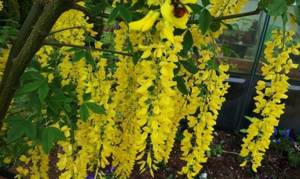
During winter snowfalls, the crown can be overloaded with snow, under the influence of which branches often break. To prevent this from happening, it is necessary to periodically shake off the snow.
Bean propagation
Vegetative propagation refers to the following methods presented:
- Cuttings - to obtain planting material in August, young branches should be cut and rooted on the site in loose soil in partial shade. After planting, the cuttings need to be covered with plastic bottles until the root system forms. Watering future bean trees should be done carefully. In the first year of life, young shrubs need to be covered for the winter.
- Grafting – varietal cuttings should be grafted onto species-specific rootstocks. The grafting site must be chosen close to the ground.
- By layering - to propagate using this method, you need to bend the lower branch to the ground and sprinkle it with soil. In the place where the roots should appear, you need to make several cuts on the bark. After about 30-35 days, the first roots will begin to appear; when they grow enough, the branch can be cut off and planted in open ground.
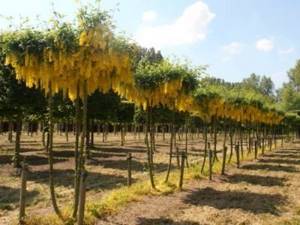
Reproduction
There are a lot of methods for propagating broom: seed, cuttings, division, grafting and layering.
Seminal
This method is the most common because it produces the most frost-resistant specimens, and it does not require much expense.
The main difficulty is that the seeds do not remain viable for long, so they must be extremely fresh. There is a thick coating on the surface of the seeds, which is difficult for tender sprouts to break through. To make their task easier, preliminary stratification is necessary for two to three months in the refrigerator. After this, the seeds are carefully rubbed with sandpaper or placed in a bag of sand, where they are thoroughly shaken so that the grains of sand damage the seal of the cover.
The seeds are placed in the ground to a depth of 1 cm and watered. After about a month, the first seedlings appear and grow very quickly. After the third leaf appears, they are planted in separate containers. Caring for sprouts consists of periodic watering, fertilizing once a month with nitrogen mineral complexes and loosening the soil. The first winter, the sprouts overwinter in the house, and after a year they are planted in open ground. Young specimens should be covered for two or three winters after planting to prevent them from freezing. With this propagation method, flowers can be seen for the first time in the fourth year.
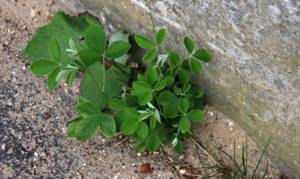
Around mature broom trees and shrubs, seeds scatter randomly, and a lot of shoots form. Such sprouts can be dug up and planted in a permanent place. As a rule, they turn out to be the most frost-resistant.
By layering
In spring or autumn, a healthy branch is bent to the ground and its middle part is covered on top. Roots grow under the ground in the first season, and the next year the plant can be cut off from the mother plant and planted separately.
Cuttings
Cuttings are the best method for hybrid varieties, with which you can preserve all the decorative properties. The size of the cuttings is 15-20 cm, they should have more than three buds. After planting in moist, loose soil, they are covered with a bag to create increased humidity. When new growth appears, the bag can be removed. The cuttings develop for a year in a house or greenhouse, after which they are ready to be transplanted into open ground.
Dividing the bush
This method is suitable for varietal bean plants, but adult shrubs tolerate it very difficult, the percentage of specimens that successfully take root after division is not large, so it is used extremely rarely.
Diseases and pests
Since bean is a poisonous crop, pests avoid it. However, it can be affected by a disease such as powdery mildew . It begins to develop when the soil is waterlogged or during prolonged rainy weather.
You can notice the appearance of powdery mildew on the trunk, which will begin to become covered with a gray coating. In the advanced stage, the disease also affects the leaves. When the first signs of powdery mildew appear, the bean plant should be sprayed with a solution of the fungicide “Topsin M 500 SC”, according to the instructions on the package.
Another problem that worries Laburnum owners is the lack of flowering. So, why doesn’t the bean flower bloom? There can be many reasons for this, including the wrong place for planting, too dense soil, lack of nutrients, lack of winter shelter and frozen branches, diseases.
However, most often the absence of luxurious racemose inflorescences is due to the fact that the tree does not have enough light. By transplanting it to a sunny area, you can solve this problem once and for all.
